Vancouver International Airport
| Vancouver International Airport Aéroport international de Vancouver | |||||||||||||||||||
|---|---|---|---|---|---|---|---|---|---|---|---|---|---|---|---|---|---|---|---|
.svg.png) | |||||||||||||||||||
|
| |||||||||||||||||||
|
IATA: YVR – ICAO: CYVR – WMO: 71892 | |||||||||||||||||||
| Summary | |||||||||||||||||||
| Airport type | Public | ||||||||||||||||||
| Owner | Transport Canada | ||||||||||||||||||
| Operator | Vancouver Airport Authority | ||||||||||||||||||
| Serves | Metro Vancouver | ||||||||||||||||||
| Location | Richmond, British Columbia | ||||||||||||||||||
| Hub for | |||||||||||||||||||
| Focus city for | |||||||||||||||||||
| Time zone | PST (UTC−08:00) | ||||||||||||||||||
| • Summer (DST) | PDT (UTC−07:00) | ||||||||||||||||||
| Elevation AMSL | 13 ft / 4 m | ||||||||||||||||||
| Coordinates | 49°11′41″N 123°11′02″W / 49.19472°N 123.18389°WCoordinates: 49°11′41″N 123°11′02″W / 49.19472°N 123.18389°W | ||||||||||||||||||
| Website | www.yvr.ca | ||||||||||||||||||
| Map | |||||||||||||||||||
 CYVR Location in Vancouver | |||||||||||||||||||
| Runways | |||||||||||||||||||
| |||||||||||||||||||
| Helipads | |||||||||||||||||||
| |||||||||||||||||||
| Statistics (2015) | |||||||||||||||||||
| |||||||||||||||||||
|
Sources: Canada Flight Supplement[2] Environment Canada[3] Movements from Vancouver Airport Authority[1] Passenger statistics from Vancouver Airport Authority.[1] | |||||||||||||||||||
Vancouver International Airport (IATA: YVR, ICAO: CYVR) is located on Sea Island in Richmond, British Columbia, Canada, about 12 km (7.5 mi) from Downtown Vancouver. It is the second busiest airport in Canada by aircraft movements (316,182[1]) and passengers (20.3 million[1]), behind Toronto Pearson International Airport. It has non-stop flights daily to Asia, Europe, Oceania, the United States, Mexico and other airports within Canada. The airport has won several notable international best airport awards; it won the Skytrax Best North American Airport award in 2007 and 2010 through 2016.[4] The airport also made the list of top 10 airports in the world for the first time in 2012, rated at 9th (2012), 8th (2013), and 9th (2014) overall.[5] It is the only North American airport included in the top 10 for 2013 and 2014.[5][6][7][8] YVR also retains the distinction of Best Canadian Airport in the regional results.[9] It is a hub for Air Canada as well as a focus city for WestJet. It is also an operating base for Air Transat. Vancouver International Airport is one of eight Canadian airports that have US Border Preclearance facilities. It is also one of the few major international airports to have a terminal for scheduled floatplanes.
Vancouver International Airport is owned by Transport Canada[10] and is managed by Vancouver Airport Authority,[11] which also manages other airports around the world through its Vancouver Airport Services subsidiary.
History
In 1929 the city of Vancouver purchased land on Sea Island for aviation purposes, replacing the original grass airstrip at Minoru Park. During World War II, the airports and its original terminal, now the South Terminal, were leased to the Federal government and operated by the Department of National Defence and the Department of Transport. The airport was a base for Royal Canadian Air Force training. The crews and their families were housed in a new townsite on the island, named Burkeville after Boeing president Stanley Burke. Funds from the lease were used to purchase additional land for new hangars and a production plant for Boeing Aircraft of Canada.[12]
The present main terminal was completed in 1968 and has since been expanded to include separate domestic and international terminals. A north runway was completed in 1996.
In 2011 the airport announced that it will enact a program aiming to encourage airlines to start more flights between Vancouver and Asia.[13]
The term Pacific Gateway describes YVR for its proximity to Asia in relation to the rest of Canada, as well as the large Asian population and Canadian-Asian business connections in the region, make Vancouver International Airport the major gateway between Canada and Asia. It has more trans-Pacific flights than any other airport in Canada.
Terminals
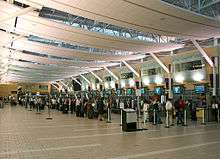
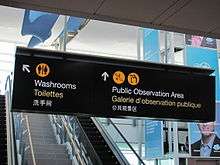
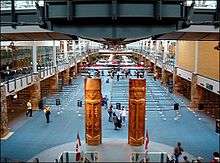

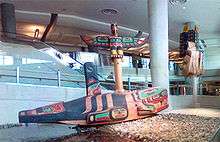

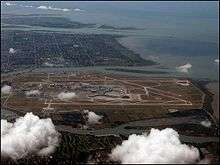
Vancouver International Airport has two terminals: the Main Terminal and the South Terminal. Free Wi-Fi is available in all sections of the airport.
Main Terminal
The Main Terminal is divided in two sections: the Domestic Terminal and the International Terminal. The majority of flights operate at the Main Terminal. The two sections are connected both pre-security and post-security; however, the US border preclearance area is separated off using movable glass partitions which can be adjusted based on the arrangement of swing gates between concourses D and E.
Domestic Terminal
The Domestic Terminal was constructed in 1968 by the Vancouver-based firm Thompson, Berwick and Pratt[14] and recently given a top-to-bottom renovation by Vancouver architect Kasian Kennedy.[15] The Domestic terminal consists of three concourses (A-C).
Concourse A
Concourse A consists of six temporary gates: A6 through A10 and A12. These gates are used by WestJet Encore. A new permanent ground-loading concourse is planned to start construction in 2016.
Concourse B
Concourse B comprises gates B12 through B23 and B26 through B28, for a total of 15 gates. Gates B14 to B17 have provisions allowing international arrivals in the future. Gate B23 is a ground loading ramp accessing stands 23A, 23B, and 23C. Concourse B is for domestic flights by Air North, Air Transat, Central Mountain Air, First Air, Sunwing Airlines, and WestJet.
Concourse C
There are 24 gates in Concourse C: C29 through C52. This is the hub for Air Canada and Air Canada Express domestic flights. C50, C51 and C52 are also frequently used by WestJet as they are swing gates and can be used for international arrivals and departures (designated as D50 to D52). In addition, C48 and C49 can receive international/US arrivals.
International Terminal
The International Terminal was designed by Vancouver-based Architectura (now Stantec Architecture Ltd.) with Kansas City-based HNTB Corporation (1994–96).[14] YVR is one of eight Canadian airports with United States border preclearance facilities, which are situated in the International Terminal. All gates in the International Terminal can accept flights arriving from all international and US origins: passengers are directed onto overhead walkways which lead to the customs and immigration area.
Concourse D
Concourse D is used by all international-bound and select US-bound flights from Vancouver. There are 14 gates: D50 to D55, D58, D64 to D67, D70, D71, and D73. All of these gates can handle wide-body aircraft; six gates are fitted with 2 jet bridges, two of which can handle the Airbus A380. British Airways operates the A380 seasonally to Vancouver.
D50 to D52 are swing gates that can be used by domestic flights (designated C50 to C52). D67 through D73 are swing gates which may be partitioned off to allow for a higher number of US preclearance flights (designated E67 through E73).
Concourse E
Concourse E is the US border preclearance area and consists of 20 gates: E75 to E87 and E90 to E96. Gates E75 to E78 can accommodate smaller wide-body aircraft and are swing gates which can be used for international departures (as gates D75 to D78). Gate E95 accesses stands 95A and 95B.
The majority of US-bound flights operate from Concourse E; the only exceptions are flights from an international origin (Cathay Pacific's Hong Kong—Vancouver—New York and Philippine Airlines' Manila—Vancouver—New York flights), or flights that depart after 8:30pm (e.g. Delta Air Lines' Vancouver—New York flight).
South Terminal
The South Terminal is a portion of the original pre-1968 terminal which is still in use. This includes the floatplane terminal. It also houses the corporate headquarters and main base of Pacific Coastal Airlines[16] and Harbour Air.[17]
The South Terminal serves regional airlines which fly mostly within British Columbia, in addition to helicopters and chartered flights.[18]
Awards
YVR has been awarded the Skytrax World Airport Awards Best Airport in North America a record seven years in a row. It is also currently ranked 14th worldwide.[19]
Architecture
YVR's interior has a uniquely British Columbian theme, featuring one of the most extensive collections of Pacific Northwest Coast Native art in the world, and blues and greens to reflect the colours of the land, sea and sky. This theme was put in place by Vancouver-based Architectura (now Stantec Architecture Ltd). The airport uses a great deal of carpet and vast expanses of glass to let in large amounts of natural light. One of the most noticeable places for an arriving passenger is the International arrivals hall, a large area where customs and immigration procedures are completed. Arriving passengers come down escalators leading to a platform across a large waterfall. The YVR aboriginal art collection includes wooden sculptures and totem poles. Bill Reid's sculpture in bronze, "The Spirit of Haida Gwaii, The Jade Canoe", is displayed in the international departures area. This is the second of two castings of this sculpture; the first casting, "The Spirit of Haida Gwaii, The Black Canoe", is now displayed outside the Canadian Embassy in Washington D.C.[20] The Institute for Stained Glass in Canada has documented the stained glass at Vancouver International Airport.[21]
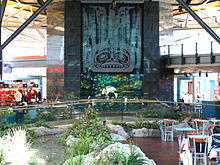
Accessibility
Vancouver International Airport is well regarded as one of the most accessible airports in the world. In 2004, the Vancouver International Airport was awarded of the Rick Hansen Accessibility Award, which recognizes "facilities and communities that improve the quality of life for people with mobility limitations".[22] The Vancouver International Airport has exceeded national building code requirements with respect to access for people with disabilities, which Hansen has said "benefits not only people in wheelchairs, but the elderly, the blind, parents pushing strollers and everyone else with mobility problems".[22]
Since 1992, the Vancouver Airport Authority has been working with an independent accessibility consultant to eliminate the physical barriers in the built environment and is "committed to providing fully accessible terminal facilities for people of all backgrounds and capabilities".[23] With 80% of the vacationing traveling public over the age of 55, and with more than 550 million people world-wide that have a disability, the Vancouver International Airport's commitment to meaningful access is a fundamental part of good customer service.[24]
Designated short-term parking spaces and curb-side ramps are available on each level of the terminal building for vehicles displaying a valid SPARC permit, and are located next to main doors near check-in counters and baggage claim areas for easier access. Lowered counters with toe clearance for wheelchair users are also available at check-in, customer care and all retail outlets in the Vancouver Airport. Bathrooms have also been designed to be wheelchair accessible with doorless and no-touch entry features, lowered sinks and handsfree bathroom dispensers. Grab bars and emergency call buttons are also present in all wheelchair accessible toilet stalls.[25]
Low resistance carpeting and other materials such as laminate flooring have been utilized throughout the airport to make it easier for people using wheelchairs and walkers to move throughout the airport. Elevators are large and allow for easy turning in a wheelchair and special wheelchairs designed to fit down aircraft aisles are utilized to assist with boarding and de-planing. Wheelchair lifts have been installed at aircraft gates to provide disabled passengers with their own wheelchairs as quickly as possible after an aircraft lands in Vancouver.[23]
Features that have been implemented throughout the airport to aid those with hearing loss include a public address system to reduce noise pollution for those with hearing aids. The Vancouver International Airport has installed more individual speakers in a given space than is standard, which allows the volume of the speakers to be turned down and provides a better quality of sound. At check-in counters, amplified handsets are available to aid those with hearing aids, and all telephones throughout the airport have adjustable volume controls. "Visual pagers" are dedicated video monitors that are located throughout the airport and convey important information to travellers that have hearing impairments. In the event of an emergency, a video override system displays large bold messages on all entertainment systems, and provides information about the type of emergency and the required course of action from the public. Strobe fire alarms have also been installed throughout the airport and have been carefully programmed to prevent seizures to those with epilepsy.[25] The Vancouver Airport has its own TTY telephone number for incoming inquiries about airport operations and within the terminal there are also 23 public telephone equipped with TTY at both stand up and seated positions.[25]
Vancouver International Airport also has numerous features that have been implemented to assist visually impaired travellers. Three types of flooring are utilized throughout the terminal and function as a texturized guide to assist travellers in identifying their location within the airport. In areas with tile or terrazzo, patterns in the tile help to identify exits. Areas that have carpet help to identify that a gate is close by and areas with laminate flooring indicate retail spaces.[23] Tactile maps are also available at customer service counters throughout the airport, and braille and tactile lettering are used throughout the airport to indicate building features such as washrooms.[25]
Green Coat Ambassadors
Vancouver Airport Authority was one of the first airports in North America to institute a volunteer program in 1989.[26] Volunteers in green vest/jacket are deployed around the airport to provide information, customer service and be the 'eyes and ears' for the various partners in the airport community between the hours of 6 am to 10 pm everyday.[27] Volunteers are given basic training in airport operations and undertake many of the similar trainings mandated to airport employees. Each volunteer is required to obtain Transportation Security Clearance and Restricted Area Identification Card for the purposes of accessing the restricted and sterile areas of the terminal.
YVR Sustainability
Airlines and destinations
Passenger
- Notes
- ^1 U.S.-bound flights that depart after 8:30 pm use Concourse D and do not go through U.S. preclearance in Vancouver.
- ^2 Select Philippine Airlines flights continue to/originate in Toronto. However, Philippine Airlines does not have eighth freedom rights to transport passengers solely between Vancouver and Toronto, and thus only carries passengers traveling between Vancouver and Manila on those flights.
- ^3 Domestic WestJet flights may also use gates C50–C52.
Cargo
Statistics

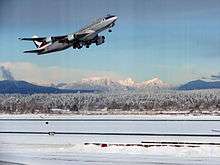
Annual traffic
| Year | Passengers | Year | Passengers | Year | Passengers |
|---|---|---|---|---|---|
| 2010 | 16,778,774 | 2000 | 16,032,531 | ||
| 2009 | 16,179,312 | 1999 | 15,806,499 | ||
| 2008 | 17,852,459 | 1998 | 15,508,109 | ||
| 2007 | 17,495,049 | 1997 | 14,818,564 | ||
| 2006 | 16,922,226 | 1996 | 14,037,174 | ||
| 2015 | 20,315,978 | 2005 | 16,418,883 | 1995 | 12,006,973 |
| 2014 | 19,358,203 | 2004 | 15,725,694 | 1994 | 10,830,796 |
| 2013 | 17,971,883 | 2003 | 14,321,504 | 1993 | 10,235,015 |
| 2012 | 17,596,901 | 2002 | 14,877,536 | 1992 | 9,935,285 |
| 2011 | 17,032,780 | 2001 | 15,476,762 |
Cost
In May 2005, the federal government, which owns the airport land, announced it was cutting rent costs by 54%. The rent reductions will cut the cost of the lease by approximately $840 million CAD between 2006–2020, or $5.0 billion over the term of the lease, which ends in 2052. Currently, the airport authority pays about $80 million each year in rent.
Passengers traveling through YVR are no longer required to pay a separate airport improvement fee; it is now included in the ticket price.
Public transit connections
Rapid Transit (SkyTrain)
The international and domestic terminals are served by YVR–Airport Station, a terminus station of the Canada Line. A connector ($117 million, completed in 2007) links the international terminal with the domestic terminal and serves as the arrival and departure area for users of the Canada Line.[42] The Canada Line, one of three existing lines of Metro Vancouver's SkyTrain rapid transit network, opened in August 2009, in advance of the 2010 Winter Olympics in the following February.[43] Vancouver's airport was the only one in Canada with a rail rapid transit connection, until Toronto Pearson opened the Union Pearson Express in 2015. Vancouver International Airport contributed $300 million to the Canada Line construction.
Bus
Late at night and during Canada Line service interruptions, the N10 night bus connects the airport's international and domestic terminals to Richmond and downtown Vancouver. The airport's south terminal is served by the C92 bus, which connects to the Canada Line at Bridgeport Station.
Expansion
YVR completed a $1.4-billion multi-year capital development plan, which included a four-gate expansion to the International Terminal Wing, completed in June 2007. Two of the four new gates are conventional wide-bodied gates and two are able to accommodate the Airbus A380. The international terminal addition includes interior design elements intended to represent British Columbia, including a stream in a pathway and fish and jellyfish tanks.
A five-gate and food and retail expansion was completed in 2009 for Domestic Terminal's C-Pier. The train that links downtown Vancouver, YVR and Richmond opened in August 2009.
Vancouver International Airport Authority has developed a 2007-2027 Master Plan and Land Use Plan, a look forward 20 years to ensure YVR will be able to accommodate the passengers it expects. It is asking the community for input and toured local malls with an informational display to elicit feedback. The tour is complete, but the public can still provide feedback through the Master Plan section of the YVR website, where a copy of the draft Master Plan recommendations is also available.[44]
Operation Yellow Ribbon
As a result of the September 11 Attacks, the airspace over the United States was shut down. Aircraft over the North Atlantic and Pacific bound for the United States were therefore diverted to Canadian airports. Vancouver International Airport accommodated 34 of these flights (3rd highest after Halifax and Gander) amounting to a total of 8,500 passengers.
The airport won the 2001 Airport Management Award from the B.C. Aviation Council[45] and was cited for overcoming many challenges in a professional and compassionate way.[46]
Vancouver International Airport Authority
YVR is managed by Vancouver International Airport Authority, created in 1992 to take over day-to-day management of the airport from Transport Canada.[47] VIAA has a staff of 400.[47]
The VIAA is headed by the CEO and President Craig Richmond.
Past CEO and Presidents includes:
- Larry Berg 1998-2013
- David Lee Emerson 1992-1998
FBOs
There are several fixed-base operators that service aircraft at Vancouver International Airport:
Other facilities
At one time Pacific Western Airlines had its corporate headquarters at the airport.[48]
Fire and policing
Vancouver International Airport Emergency Services Team is the primary fire services at the airport. The airport fire station and tenders (4) are owned by the Vancouver Airport Authority. Richmond Fire has additional resources when required from Fire Hall 1 at 6960 Gilbert Road, as well as the Canadian Coast Guard.
Policing at the airport is provided by the Royal Canadian Mounted Police Airport Detachment.
Catering Kitchens
- Gate Gourmet - formerly by Cara Operations
- CLS Catering Services Limited - joint venture with Cathay Pacific Catering Services and LSG SkyChefs
Accidents and incidents
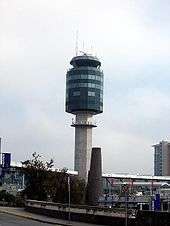
- On February 7, 1968, a Canadian Pacific Airlines Boeing 707 overran a runway and hit a building, while landing in heavy fog, killing one crew member.
- On March 1, 1970, Vickers Viscount CF-THY of Air Canada collided in mid-air with Ercoupe 415 CF-SHN on approach to Vancouver International Airport. The Ercoupe pilot was killed.[49]
- On August 19, 1995, Douglas C-47B (DC-3) C-GZOF of Air North crashed during an emergency return to the airport killing one of the three crew. The aircraft was on a ferry flight to Prince Rupert Airport when the starboard propellor went into overspeed and the decision was made to return to Vancouver International.[50]
- On October 19, 1995, a Canadian Airlines McDonnell Douglas DC-10 aborted takeoff on runway 26 (now 26L) two seconds after the V1 call. The aircraft ended up in the soft ground west of the end of runway, causing the failure of the nose gear. All 243 passengers and 14 crew escaped with no more than minor injuries.[51]
- On September 11, 2001, an Air China 747 from Beijing to San Francisco, was escorted by two U.S. F-15s onto the airport's north runway during Operation Yellow Ribbon, apparently due to a communication problem.
- On October 14, 2007, a Polish immigrant, Robert Dziekanski, died after being shot with a taser by the Royal Canadian Mounted Police at the airport. Dziekański, who did not speak English, became agitated after waiting approximately 10 hours at the arrivals hall because he could not find his mother. While police were attempting to take Dziekanski into custody he was tased by officers and subsequently died. The subsequent Braidwood Inquiry began in May 2008. In June 2010, the judge found that the use of the Taser was not justified. The RCMP issued an apology to Dziekanski's mother. The commission also found that Tasers have the capability to injure or kill by causing heart irregularities, especially where the individual is medically or emotionally compromised.[52]
- On October 19, 2007, at approximately 4:10 pm, a Piper Seneca bound for Pitt Meadows Airport took off from YVR and crashed into a nearby apartment building in Richmond. The pilot was the sole occupant of the plane. He was killed in the crash. Two others were injured, both of whom were in the apartment building at the time.
- On December 10, 2007 Sikh protesters paralyzed the airport caused by the deportation of illegal paralyzed refuge Laibar Singh.[53]
- On September 18, 2008, in the afternoon, an Air Canada Airbus A340 collided with an Air Canada Jazz Dash 8 aircraft. The Jazz flight was taxiing on the runway when it collided. The Air Canada flight was bound for Hong Kong. Both aircraft received damage but there were no injuries or fatalities.
- On July 9, 2009, at approximately 10:08pm, a Piper Navajo airplane originating from Victoria crashed into an industrial area in Richmond, British Columbia. The two pilots were killed. It was owned and operated by Canadian Air Charters and was carrying units of blood for Canadian Blood Services at the time. Officials say that wake turbulence was the main cause of the crash. Fatigue, along with diminished depth perception in darkness, was also a factor.[54]
- On October 27, 2011, at around 4:15pm, a Northern Thunderbird Air Beechcraft King Air 100 attempted to land on the south runway but missed by about 900 metres (3,000 ft), hitting a lamppost and car, then crashing on nearby Russ Baker Way and Gilbert Road at the west end of Dinsmore Bridge. There were seven passengers and two crew members on board; only the pilot was confirmed dead at 9:00 pm that evening, while the others survived with various injuries. Two on the ground were also injured.[55] On November 16, 2011, the co-pilot of the flight died as well.[56]
Nearby major airports

References
- 1 2 3 4 5 6 "YVR Traffic Update (December 2015)". yvr.ca. Retrieved 2016-02-03.
- ↑ Canada Flight Supplement. Effective 0901Z 15 September 2016 to 0901Z 10 November 2016
- ↑ Synoptic/Metstat Station Information Archived June 28, 2013, at the Wayback Machine.
- ↑ "YVR > Our Blog > YVR Named Best Airport in North America". Retrieved August 10, 2015.
- 1 2 YVR Media Relations (2013-04-10). "Vancouver International Airport named Best Airport in North America". Yvr.ca. Retrieved 2013-05-16.
- ↑ "2010 Regional Airport Awards". Skytrax. 2010. Retrieved 2010-03-25.
- ↑ "2007 Regional Airport Awards". Skytrax. 2007. Archived from the original on 2007-08-11. Retrieved 2007-08-26.
- ↑ Campbell, Alan (April 23, 2012). "YVR wins best airport award again". Vancouver Sun. Retrieved 2012-05-22.
- ↑ "2006 Airport of the Year: Results". Skytrax. 2007. Archived from the original on 2007-03-18. Retrieved 2007-04-04.
- ↑ "Airport Divestiture Status Report". Tc.gc.ca. January 12, 2011. Retrieved 2011-03-03.
- ↑ "YVR Leadership". Retrieved 2012-09-20.
- ↑ "YVR > About Us > History". Retrieved August 10, 2015.
- ↑ Hume, Mark. "Vancouver airport launches plan to lure Asia-Pacific traffic Archived March 7, 2014, at the Wayback Machine.." The Globe and Mail. Wednesday January 25, 2012. Updated Friday January 27, 2012. Retrieved 2012-02-09.
- 1 2 Harold D. Kalman. "Airport Architecture". The Canadian Encyclopedia. Retrieved 2013-05-16.
- ↑ "Home | Architecture". Architecture.uwaterloo.ca. Archived from the original on January 17, 2013. Retrieved 2013-07-04.
- ↑ "Contact Us Archived June 25, 2014, at the Wayback Machine.." Pacific Coastal Airlines. Retrieved 2011-12-04. "Pacific Coastal Airlines Head Office Vancouver International Airport - South Terminal 4440 Cowley Crescent Unit 204 Richmond BC V7B 1B8"
- ↑
- ↑ "YVR > Getting To & From YVR > To& From Airport South". Retrieved August 10, 2015.
- ↑ http://www.worldairportawards.com/Awards/world_airport_rating.html
- ↑ The Spirit of Haida Gwaii: The Jade Canoe. "Archived copy". Archived from the original on March 2, 2016. Retrieved 2014-08-20.
- ↑ stained glass at Vancouver International Airport. "Archived copy". Archived from the original on March 4, 2016. Retrieved 2011-11-16.
- 1 2 Picard, A. (2004, June 12). Vancouver Airport Wins New Hansen Prize for Accessibility. The Globe and Mail
- 1 2 3 Vancouver Airport Authority. (n.d.). Fact Sheet: Vancouver International Airport: The Accessible Airport. Retrieved 10 29, 2012, from Vancouver Airport Authority: www.yvr.ca/libraries.comms_documents/The_Accessible_Airport_-_Fact_sheet.sflb.ashx
- ↑ Canadian Barrier Free Design Inc, V. A. (July, 2005). YVRAA's Access Commitment to People with Disabilities. The Vancouver International Airport Access Initiative
- 1 2 3 4 Government of Canada. (n.d.). Access to Travel. Retrieved 10 20, 2012, from Accessibility of Airport Terminals: accesstotravel.gc.ca/9b3.aspx?lang=en
- ↑ Green Coats Page Archived July 2, 2015, at the Wayback Machine.
- ↑ Green Coat FAQ Archived March 4, 2016, at the Wayback Machine.
- ↑ "Air Canada opens reservations for Taipei service in S17". Retrieved 31 October 2016.
- ↑ "Air Canada to launch Vancouver-Frankfurt and Vancouver-London Gatwick flights for Summer 2017". Canadian Aviation News. Retrieved 9 November 2016.
- ↑ "Air Canada to Launch Non-Stop Flights from Vancouver to Dallas-Fort Worth" (Press release). Air Canada. September 7, 2016. Retrieved September 7, 2016.
- ↑ "Archived copy". Archived from the original on September 15, 2016. Retrieved 2016-09-08.
- ↑ "Air Canada to launch Vancouver-Frankfurt and Vancouver-London Gatwick flights for Summer 2017". Canadian Aviation News. Retrieved 9 November 2016.
- ↑ "Air Canada plans new international routes in 2017". Retrieved 28 September 2016.
- ↑ "Beijing Capital Airlines Launching Vancouver Flights in December". Jet BC.
- ↑ "China Eastern schedules Nanjing – Vancouver Dec 2016 launch". routesonline. Retrieved 9 November 2016.
- ↑ "Corilair Official Website". Retrieved January 20, 2014.
- ↑ "Hong Kong Airlines files Vancouver schedule in S17". routesonline. Retrieved 28 November 2016.
- ↑ Sunshine Coast AirSeaplanes
- ↑ Gulf Island Seaplanes
- ↑ Carson Air
- ↑ "YVR > About Us > Facts & Stats". Retrieved August 10, 2015.
- ↑ "Public Transportation". Vancouver International Airport Authority. Retrieved 20 March 2016.
- ↑ Kelly Sinoski. "Canada Line linking Vancouver and Richmond to open Aug. 17". Vancouver Sun. Archived from the original on 2009-08-07. Retrieved 2016-03-20.
- ↑ "YVR: Your Airport 2027, 20-Year Master Plan". 2007. Retrieved 2012-09-20.
- ↑ "B.C. Aviation Council". Bcaviation.org. Retrieved 2011-03-03.
- ↑ "2001 Annual Report" (PDF). Vancouver International Airport Authority. Retrieved 2006-09-30. External link in
|publisher=(help) - 1 2 "Archived copy". Archived from the original on March 2, 2016. Retrieved 2012-09-20.
- ↑ World Airline Directory. Flight International. March 20, 1975. "497 Archived August 27, 2016, at the Wayback Machine.. "Head Office: Vancouver International Airport, Vancouver, British Columbia, Canada."
- ↑ "Accident description". Aviation Safety Network. Retrieved 2009-10-08.
- ↑ "C-GZOF Accident description". Aviation Safety Network. Retrieved 2010-06-25.
- ↑ "Transportation Safety Board of Canada Report 1995 - A95H0015". Tsb.gc.ca. July 31, 2008. Retrieved 2011-03-03.
- ↑ "Taser video shows RCMP shocked immigrant within 25 seconds of their arrival". CBC. November 15, 2007. Archived from the original on November 16, 2007. Retrieved 2007-11-15.
- ↑ "Deportation halts for Singh".
- ↑ "Wake turbulence blamed for fiery Richmond crash". The Vancouver Sun. May 28, 2011. Retrieved 2012-09-20.
- ↑ "Richmond plane crash leaves pilot dead". CBC News. October 28, 2011. Retrieved 2012-09-20.
- ↑ "GlobalBC TV Twitter". Retrieved 2012-09-20.
External links
| Wikimedia Commons has media related to Vancouver International Airport. |
- Vancouver International Airport Authority
- Vancouver International Airport page on Places to Fly, the airport directory of the Canadian Owners and Pilots Association
- Vancouver International Airport Authority Union
- Past three hours METARs, SPECI and current TAFs for Vancouver International Airport from Nav Canada as available.